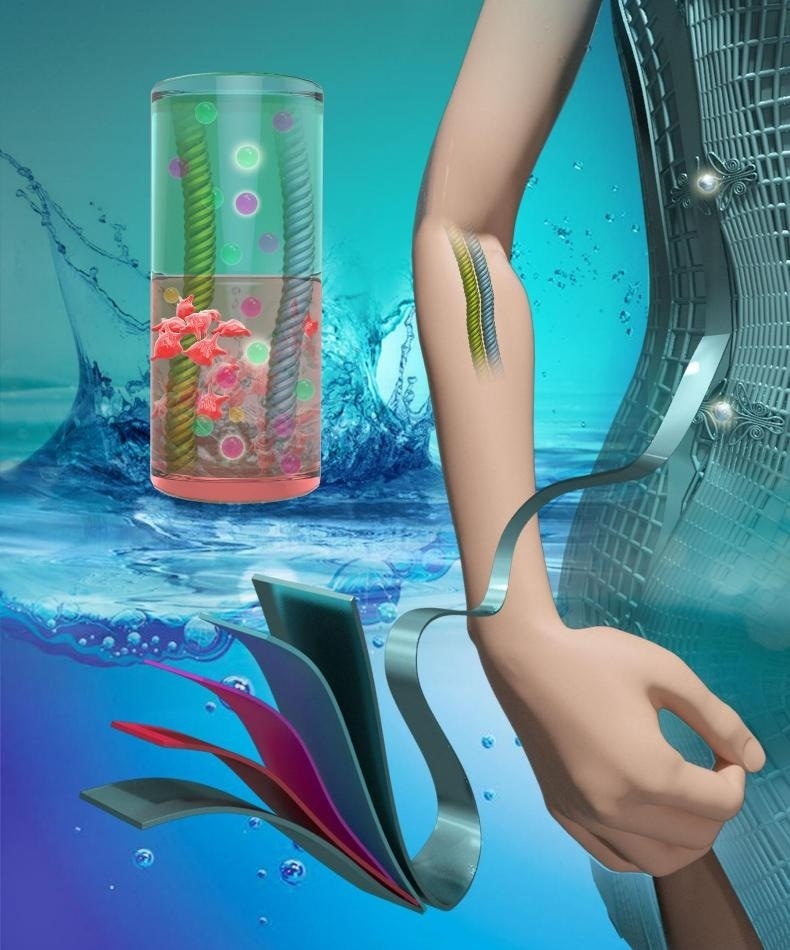Aug 14 2017
Scientists from China have designed bendable batteries that can operate by means of body-inspired fluids, for example, cell-culture medium and normal IV saline solution.
In the research, which has been reported in the Chem journal on 10th August 2017, the Researchers have developed substitutes for lithium-ion batteries by concentrating on the mechanical-stress requirements of wearable electronic equipment (e.g. smartwatches) and the safety demands of implantable electronics.
 This is an artistic rendering of fiber-shaped implantable batteries using biocompatible electrolytes. CREDIT: Guo et al.
This is an artistic rendering of fiber-shaped implantable batteries using biocompatible electrolytes. CREDIT: Guo et al.
Current batteries like the lithium-ion ones used in medical implants generally come in rigid shapes. Additionally, most of the reported flexible batteries are based on flammable organic or corrosive electrolytes, which suffer from safety hazards and poor biocompatibility for wearable devices, let alone implantable ones.
Yonggang Wang, Co-senior Author and Chemistry Professor, Fudan University and the Collaborative Innovation Center of Chemistry for Energy Materials
Safety procedures for implantable and wearable batteries normally necessitate structural fortification for avoiding the leakage of dangerous chemicals. As an alternative, the research team headed by Wang and Huisheng Peng, a Macromolecular Science Professor, substituted the flammable and hazardous liquids with inexpensive and environment-friendly sodium-ion blends. Of these blends, two were biocompatible and appropriate for implantable devices, as they were not known to cause any harm to the interior or surface of the human body.
While leakage of electrolyte is nevertheless considered to be unfavorable, the risk caused by the leakage can be reduced by using either the normal IV saline solution administered into human body during treatment or a cell-culture medium comprising vitamins, sugars, and amino acids along with sodium ions, and hence simulates the fluid surrounding human cells.
As the research team was now freed from worries of leakage that mandate the usage of protective material which make batteries unbendable and heavy, they engineered two kinds of flexible batteries. One was a two-dimensional “belt” shaped battery in which thin electrode films were affixed to a steel strand net. The other was a one-dimensional fiber-shaped battery in which a carbon nanotube backbone was surrounded by nanoparticles of electrode material. Apart from investigating biocompatible liquids, the Researchers also investigated the use of normal sodium sulfate (a reasonably inert and safe blend) as a fluid electrolyte in external wearable devices.
Upon using sodium sulfate blend as the electrolyte, the performance of both the belt-shaped and fiber-shaped batteries was higher than the previously used wearable lithium-ion batteries with regards to charge-retaining potential, or the time period for which a battery can operate without being recharged, and power yield relative to the size of the batteries. This potential was still found to be good when the batteries were folded and bent to simulate the effect of wearing a watch, sensor, or similar gadgets around a person’s arm.
Charge-retaining potential was only slightly minimized for both the cell-culture-based and saline-solution-based batteries, perhaps because the sodium-ion content in these batteries was marginally lesser than the sodium sulfate solution.
An undesired side effect in the fiber-shaped battery has given the research team ideas for probable biomedical usage. Carbon nanotubes similar to the ones that form the skeleton of the one-dimensional battery have the ability to speed up the transformation of dissolved oxygen into hydroxide ions. This process that has a negative impact on the battery capacity when ignored can enhance therapeutic potential for the treatment of bacterial infections and cancer when applied as a stand-alone process.
We can implant these fiber-shaped electrodes into the human body to consume essential oxygen, especially for areas that are difficult for injectable drugs to reach. Deoxygenation might even wipe out cancerous cells or pathogenic bacteria since they are very sensitive to changes in living environment pH. Of course, this is hypothetical right now, but we hope to investigate further with Biologists and Medical Scientists.
Yonggang Wang, Co-senior Author and Chemistry Professor, Fudan University and the Collaborative Innovation Center of Chemistry for Energy Materials